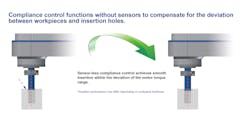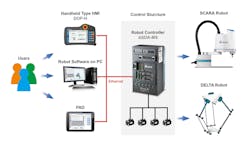SCARA Robots: The Next Move Towards Automation
Over the last decade, it comes as no surprise that businesses have been looking for ways to reduce the effects of climate change as well as the dependence on oil and gas. One of the major ways to achieve this is through electrification. While this might conjure images of electric vehicles, electrification is a broad-reaching trend that impacts everything from industrial vehicles—like forklifts in warehouses to scooters and bikes. While this trend undoubtedly drives sustainability, it has also created a demand for a certain segment of robotics.
1. What has the impact of electrification been on the industrial automation industry?
Electrification is stimulating more need for investment in electronics assembly equipment. Often, a SCARA (Selective Compliance Assembly Robot Arm or Selective Compliance Articulated Robot Arm) is utilized for this type of assembly—requiring speed, precision, and consistency to keep up with growing demand. Particularly during the pandemic, electronics assembly and automation is crucial to create a stabilized production process at a time when social distancing is a necessity. For manufacturers to produce products effectively and efficiently, we need people to operate these lines in tandem with robotic solutions that can take on the repetitive and labor-intensive aspects of manufacturing.
Electronics assembly for electrification is peaking in popularity now, but it was also why Delta originally developed its SCARA. Founded in 1971, Delta quickly became the world’s largest power supply manufacturer and thermal management solutions provider. This expertise allowed us to diversify into numerous markets, including automotive components for electric vehicles, which led to the development of cutting-edge SCARA technology.
2. Are there any other drivers increasing the adoption of SCARA robots?
Electrification is the most prevalent, but the growth of bin-picking applications for e-commerce and the overall focus on reshoring manufacturing back to the United States are significant drivers. However, one of the biggest reasons SCARA technology is growing in popularity is because of the improvement toward better accuracy and more control. In many cases, this has allowed it to replace traditional cartesian or 6-axis robots.
Why choose a SCARA robot? The need for speed, accuracy, and repeatability are more in line with the strengths of SCARA solutions. When it is critical to control forces as accurately as possible, SCARA has the advantage. For instance, if assembly requires inserting a pin, force limitations can be set to make sure it goes in properly, even if perfect alignment is an issue. Directional force control is an area where this type of robot excels at. As electronics and goods become more and more lightweight, there will be a need for the assembly robotics to have more sensitive control of torque. For a screw driving application, the SCARA can intelligently control the amount of force for the downward push and rotation of the screwdriver to ensure that fragile casings are not cracked during assembly.
Specific to Delta, we have a patented 5-axis SCARA solution that has nearly the range and capabilities of a 6-axis alternative, especially for certain applications. It allows for angle pick-and-place and 3-dimensional dispensing applications that would normally require a more expensive 6-axis robot. This is one of the advancements that will continue to make SCARA a more attractive option for other industries.
3. How is AI being used to add intelligence to SCARA robots?
AI, or artificial intelligence, is enabling industrial robots and machines to perform increasingly complex jobs that require human-like vision and recognition capabilities. A great example of AI’s advancements can be seen in SOLOMON’s intelligent, 3D vision solutions. The SOLOMON’s sensor can sit atop a random pile of parts and feed motion target information to a SCARA. It reviews the load in 3D and can tell the location that the part is sitting, the size, height, and angle needed to pick it up. This helps the robot determine the proper motion path for picking up the required object—without collision of the robot components against the bin sidewall. This is all calculated and communicated to the SCARA in real-time.
4. What are the benefits of open-source robotics?
Open source allows you to do all the kinematics yourself. When looking at a PC-based type system versus an embedded one, the PC base allows us to draw from the existing structured text or any programming languages. Most of the robots available today have their own programming environment or proprietary language. If you pick a specific robot from one vendor, you have to learn its particular programming. With each robot being different, you must learn a new code each time. If you have robots from different vendors, it can be challenging to make them work together due to the fact that there are multiple programming languages.
However, open-source allows you to have individual machine control while mixing and matching the code/text with the open-source program. But more importantly, if the OEM wants to implement their own artificial intelligence integration—which includes high-level algorithms—open-source provides that option. All they have to do is pass certain data down to the robot to execute it. The robot control just becomes an executor. The adoption of open source also opens the manufacturing industry to a broader talent pool. Now, any individual with knowledge of programming can make an easier transition into the robotics and manufacturing industry.


